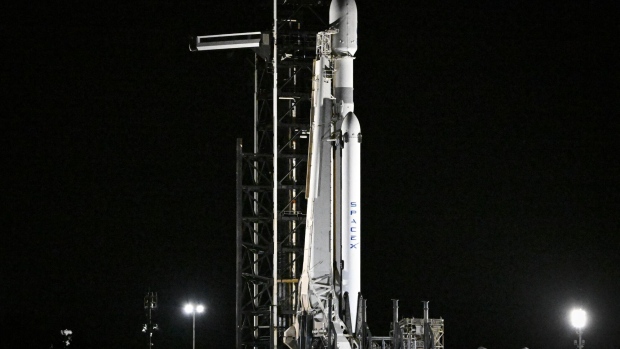Jun 25, 2024
SpaceX Falcon Heavy Launches Satellite to Track Sun Storms
, Bloomberg News

(Bloomberg) -- SpaceX’s Falcon Heavy, one of the world’s most powerful operational rockets, blasted off on Tuesday carrying into orbit a new US satellite designed to help weather forecasters monitor massive solar storms.
The rocket, comprised of three modified Falcon cores, launched from Florida’s Kennedy Space Center at 5:26 p.m. local time, according to a live webcast.
The satellite, known as GOES-U, was successfully deployed around 10 p.m. New York time, SpaceX said. Orbiting Earth at about 35,700 kilometers (22,200 miles), the satellite will use a compact coronagraph that will help weather forecasters monitor solar storms, track hurricanes and lightning, take atmospheric measurements and capture images of Earth.
GOES-U is the fourth and final satellite in a series from NOAA, the National Oceanic and Atmospheric Administration, and NASA. Once in orbit, it will be renamed GOES-19. GOES-16, the first in the series, launched in 2016.
A coronagraph is a telescope designed to block out the light of the sun so that researchers can see its corona or outermost layer. Coronagraphs help researchers predict the impact of solar flares and so-called coronal mass ejections — essentially massive expulsions of plasma and magnetic field lines — by measuring their size, velocity and density.
A solar storm can shine dazzling displays of light, such as the aurora in May. But the largest geomagnetic storm since 2003 also caused widespread radio blackouts and distortions to normal energy patterns across the Americas.
Last year, Falcon Heavy launched the world’s largest commercial communications satellite and, separately, the X-37B secretive spaceplane from the US Space Force.
SpaceX is separately developing an even bigger rocket, Starship, to launch satellites and take astronauts to the moon in the coming years.
(Updates with details on satellite deployment in third paragraph.)
©2024 Bloomberg L.P.





